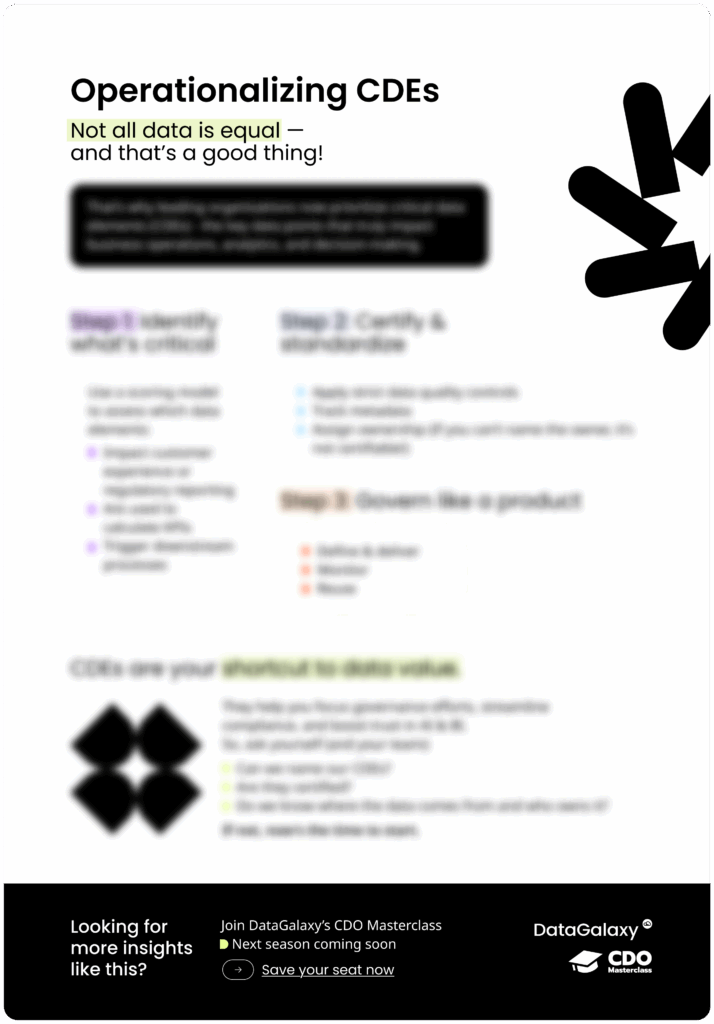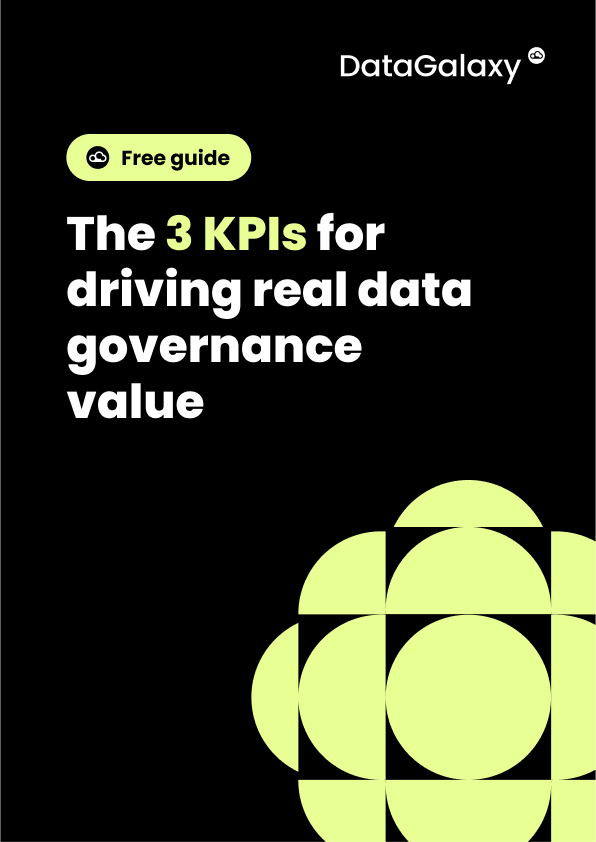The complete guide to data quality management (DQM) in the age of AI
Your business runs on data. But how reliable is that data?
If you’re making decisions based on questionable quality data, you should question the results. The risks are even higher for AI-first companies. AI doesn’t fix bad data; it recycles it.
You need a data quality management (DQM) process to deliver trusted, business-ready data at scale. So, what makes a great data quality management process tick?
TL;DR summary
Data quality management (DQM) has become a mission-critical discipline for modern data-driven and AI-powered organizations. High-quality data fuels accurate decision-making, trustworthy analytics, and safe AI deployments.
This guide explains what DQM is, why it matters, the core components of a robust DQM program, and how metadata, governance, and automation reinforce data quality at scale.
We also explore common DQM challenges—and why DataGalaxy’s Data & AI Product Governance Platform is uniquely equipped to help organizations build proactive, business-ready data quality practices.
For AI-first organizations, the stakes are even higher. Large Language Models (LLMs), Generative AI, and predictive systems are only as trustworthy as the data that trains or feeds them. Poor-quality data is not corrected by AI—AI amplifies it.
This guide outlines everything organizations need to know to build a modern, scalable, AI-ready DQM practice.
What is data quality management?
Data quality management (DQM) is a coordinated set of processes, governance practices, methodologies, and technologies that ensure data remains accurate, consistent, complete, timely, and trustworthy throughout its entire lifecycle.
DQM spans all stages of data handling from creation and ingestion to transformation, usage, and archival. Instead of reactive “data cleanup,” DQM is an ongoing, proactive discipline designed to:
- Prevent errors before they enter data systems
- Ensure data meets business and regulatory standards
- Maintain transparency over data lineage and context
- Support business teams with reliable, fit-for-purpose data
- Protect downstream analytics and AI models
A strong DQM program establishes a culture of data trust, where employees at every level rely on consistent, verified data to inform their decisions.
The importance of data quality & DQM
Business decisions rely on trusted data
Every strategic move—pricing models, financial forecasting, product decisions, customer segmentation—relies on data. Poor-quality data leads to:
- Faulty analysis
- Incorrect predictions
- Poor business decisions
- Lost revenue and market opportunities
Regulatory pressure is rising
Compliance frameworks such as GDPR, CCPA, HIPAA, and emerging AI regulations require organizations to demonstrate data accuracy, transparency, and integrity.
Bad data now represents real legal risk.
Automation & AI magnify errors
AI systems—including LLMs, RAG applications, and predictive models—cannot self-correct flawed input. Poor-quality training or operational data leads to:
- Hallucinations
- Model drift
- Biased outputs
- Regulatory exposure
- Erosion of user trust
Customer experience depends on data quality
Inconsistent or inaccurate customer data results in:
- Broken personalization
- Failed marketing campaigns
- Poor service interactions
- Frustration and churn
Teams lose time & money fixing bad data
Research shows analysts and data engineers spend up to 40% of their time resolving data issues rather than generating value.
Essential elements of a modern, robust DQM process
1. Define what “Good data” means
Every organization has its own expectations for what constitutes “high-quality” data.
Business stakeholders, data owners, and governance leaders must collaborate to define:
- Accuracy (Is it correct?)
- Completeness (Are crucial fields missing?)
- Consistency (Does it match across systems?)
- Timeliness (Is it updated at the needed frequency?)
- Uniqueness (Are there duplicates?)
- Validity (Does it meet defined formats/rules?)
CDO Masterclass: Upgrade your data leadership in just 3 days
Join DataGalaxy’s CDO Masterclass to gain actionable strategies, learn from global leaders like Airbus and LVMH, and earn an industry-recognized certification.
Save your seat!These quality dimensions should be formalized as data quality standards, SLAs, or acceptance criteria for ingestion and use.
2. Profile data at the source
Data profiling analyzes incoming data to identify:
- Missing values
- Format inconsistencies
- Structural anomalies
- Unusual statistical distributions
- Outliers or unexpected patterns
This proactive approach helps teams:
- Catch problems before they propagate
- Prevent downstream impacts
- Understand data shape and behavior
- Prioritize remediation early
Profiling is essential when onboarding new data sources or integrating third-party data.
3. Cleanse & standardize data
Once issues are detected, organizations must apply data cleansing techniques.
These include:
- Deduplication
- Format standardization (e.g., dates, codes, product SKUs)
- Correction of invalid entries
- Data enrichment (adding missing details from authoritative sources)
- De-normalization to support analytics
Automation tools significantly reduce manual overhead and ensure consistent transformations across pipelines.
4. Validate data at every ingestion point
Validation rules ensure data meets quality requirements before entering critical systems.
These rules may include:
- Schema validation
- Reference data checks
- Accepted value ranges
- Completeness thresholds
- Cross-field logic (e.g., end_date > start_date)
Integrating validation into ingestion pipelines ensures that bad data is stopped, not circulated.
5. Establish governance & accountability models
Data quality only works when responsibility is clear. A modern data governance framework should define:
Key roles
- Data Owners: Accountable for quality and business rules
- Data Stewards: Operational guardians maintaining quality
- Data Engineers: Implementers of quality checks and pipelines
- Data Consumers: Analysts, product teams, AI teams
Key governance structures
- Data standards
- Role-based access controls
- Data issue management workflows
- Data quality KPIs and dashboards
- Stewardship playbooks
Governance transforms DQM from a technical task to a cross-organizational discipline.
Operationalizing
CDEs
Do you know how to make critical data elements (CDEs) work for your teams?
Get your go-to guide to identifying and governing critical
data elements to accelerate data value.

6. Continuously monitor & improve data quality
DQM is a living practice. Organizations should use:
- Data health dashboards
- Quality scoring systems
- Automated alerts
- Trend analysis
- Root-cause analysis
- Regular audits
- Feedback loops with business teams
Continuous monitoring ensures data health stays aligned with evolving business needs and regulatory expectations.
The role of metadata, data lineage & data governance platforms for DQM
Metadata: The foundation of trusted data
Metadata provides context for understanding:
- Where data comes from
- How it transforms
- How it relates to other datasets
- Who owns it
- How it is used
Metadata management tools help document and standardize this information.
Data catalogs: Enhancing discoverability & trust
A data catalog functions as the authoritative knowledge layer where users can:
- Discover datasets
- Understand dataset context
- Review data quality scores
- Analyze lineage
- Access business definitions
- Tag and classify data products
Data lineage: Ensure transparency & compliance
Lineage visualizations trace data’s full journey, supporting:
- Impact analysis
- Root-cause analysis
- AI model accountability
- Compliance with audits
Why this matters for AI governance
High-quality metadata is essential for:
- Building reliable RAG pipelines
- Training trustworthy models
- Mitigating bias
- Ensuring AI transparency and explainability
- Supporting upcoming AI regulations (EU AI Act, NIST AI RMF, ISO/IEC 42001)
Centralize all your data assets in one unified platform, automatically build and maintain lineage across systems, and enrich every asset with AI-powered context. With DataGalaxy, teams can quickly search, discover, and understand the data they need, while ensuring full traceability and trust.
Discover the DataGalaxy differenceCommon challenges in data quality management
Despite its importance, organizations struggle with DQM because of:
Data sprawl across modern architectures
Hybrid clouds, SaaS tools, microservices, and decentralized data ownership increase complexity.
Growing volume & velocity of data
Constant ingestion makes manual quality checks impossible.
Business requirements change rapidly
New products, markets, and regulations require continuous realignment.

The 3 KPIs for driving real data governance value
KPIs only matter if you track them.
Move from governance in theory to governance that delivers.
Download the free guideLack of shared accountability
Without governance, quality becomes “someone else’s problem.”
Incomplete visibility
Without lineage and metadata, teams can’t trace the origins of issues.
AI introduces new risks
Models require fully traceable, compliant, and trustworthy data. Poor-quality data undermines AI safety and reliability.
What is the business impact of having high-quality data?
Organizations that invest in DQM see benefits across nearly every function:
Increased decision accuracy
Leaders trust their dashboards and analytics
More reliable AI & predictive models
High-quality, well-governed training data reduces hallucinations and model drift
Improved customer experience
Better personalization, fewer service failures, and consistent interactions
Reduced operational costs
Less rework, fewer outages, faster decision cycles
Regulatory readiness
Auditors and regulators can verify lineage, context, and data integrity
Accelerated innovation
Teams spend less time fixing data and more time using it
DataGalaxy for modern data quality management excellence
DataGalaxy is purpose-built to help organizations shift from reactive data cleanup to proactive, automated, collaborative data quality assurance.
1. Real-time data pipeline monitoring
Detect anomalies, schema changes, and quality issues before they cause downstream damage.
2. Automated quality rules & policy enforcement
Custom validation rules ensure every dataset consistently meets defined standards.
3. Complete, end-to-end lineage
Visualize every transformation and data movement—from source to dashboard to AI model.
4. Deep metadata management
Centralize business definitions, ownership, classifications, and context.
5. Integrated collaboration tools
With Microsoft Teams and Slack integrations, data stewards and engineers can resolve issues rapidly and transparently.
6. Built for AI governance
DataGalaxy supports data product governance, model explainability needs, and data lineage requirements mandated by upcoming AI regulations.
7. A unified data & AI product governance platform
Govern data, AI assets, metadata, lineage, quality, and ownership—together in one connected system.
Your blueprint for sustained data quality
To maintain high data quality long-term, organizations should:
- Establish business-aligned data quality standards
- Profile, validate, and cleanse data at ingestion
- Formalize ownership and steward responsibilities
- Centralize metadata and lineage
- Automate monitoring and alerts
- Build a culture of data trust across teams
- Use platforms like DataGalaxy to orchestrate governance end-to-end
The continuous journey toward data quality excellence
Data quality is never a one-time project. It is an evolving program that matures alongside your business, technology stack, and regulatory landscape.
Future trends shaping the next era of DQM include:
- AI-assisted anomaly detection
- Automated quality scoring
- Real-time pipeline validation
- Data product quality SLAs
- Self-service quality reporting dashboards
- AI governance frameworks requiring traceability
Organizations that combine automation, governance, and collaboration will be best positioned to scale trustworthy AI and analytics.
FAQ
- Why is metadata important?
-
Metadata explains what data means, where it comes from, and how to use it. It simplifies finding, organizing, and managing data, boosting trust, compliance, and decision-making. Like a roadmap, metadata gives teams clarity and confidence to work efficiently.
- What is data lineage?
-
Data lineage traces data’s journey—its origin, movement, and transformations—across systems. It helps track errors, ensure accuracy, and support compliance by providing transparency. This boosts trust, speeds up troubleshooting, and strengthens governance.
- Why do modern data catalogs include lineage and governance?
-
Because documentation alone isn’t enough. Data lineage shows how assets flow and transform. Governance ensures trust, access control, and compliance. Together, they turn a static catalog into an intelligent, collaborative platform.
- How do you improve data quality?
-
Improving data quality starts with clear standards for accuracy, completeness, consistency, and timeliness. It involves profiling, fixing anomalies, and setting up controls to prevent future issues. Ongoing collaboration across teams ensures reliable data at scale.
- What is data quality management?
-
Data quality management ensures data is accurate, complete, consistent, and reliable across its lifecycle. It includes profiling, cleansing, validation, and monitoring to prevent errors and maintain trust. This enables smarter decisions and reduces risk.
Key takeaways
- Data quality is foundational for accurate analytics, compliance, and safe AI.
- DQM requires clear standards, governance, metadata, and ongoing monitoring.
- Modern architectures and AI make proactive automation essential.
- DataGalaxy provides the complete toolkit for enterprise-grade data quality management.
- Organizations with strong DQM unlock better decisions, smoother operations, and competitive advantage.


